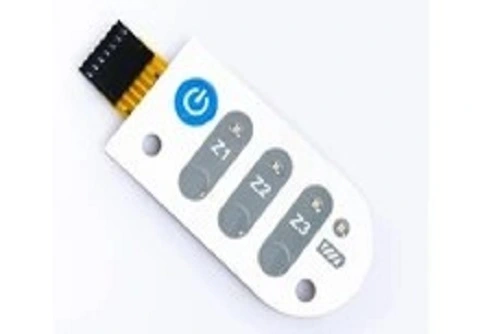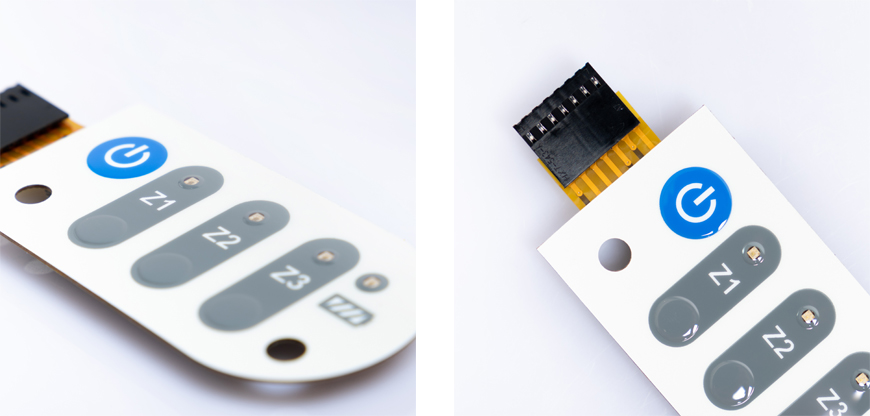
In today's fast-paced world, technology is constantly evolving, demanding innovations in electronic components. Flex PCB membrane switches have emerged as a vital component in various electronic devices, providing versatility, reliability, and seamless user interfaces. In this comprehensive guide, we will delve into the world of flex PCB membrane switches, exploring their applications, advantages, manufacturing process, and much more.

Flex PCB Membrane Switches are designed with multiple layers, each serving a specific function. The typical construction of a Flex PCB Membrane Switch includes:
Top Layer (Graphic Overlay): The topmost layer, often made from polyester or polyimide, features the printed symbols, logos, and buttons. This layer provides a user-friendly interface, allowing for easy interaction.
Conductive Layers: Beneath the top layer, there are conductive traces that are usually printed onto flexible substrates. These traces form the circuit pathways that connect the switch to the device it controls.
Spacer Layer: A non-conductive spacer separates the conductive layers, preventing electrical short circuits and ensuring that pressing a key creates proper contact with the underlying circuit.
Bottom Layer (Circuit Board): The bottom layer is where the switch’s electrical connections are made, often integrating with the larger system or device. It is typically printed on a flexible circuit material like polyimide or PET.
Flex PCB Membrane Switches operate on the principle of pressure-sensitive contact. When a user presses a specific button or key, the pressure causes the conductive layers to come into contact, completing the circuit and triggering the desired action. The flexibility of the switch ensures that it responds immediately, while the tactile feedback provides a clear indication to the user that the input has been registered.
Flex PCB Membrane Switches are used in a wide variety of applications due to their versatility, space-saving design, and reliability. Here are some of the most common applications:
In consumer electronics, Flex PCB Membrane Switches can be found in devices like remote controls, keyboards, gaming consoles, and smartphones. Their thin and flexible nature makes them ideal for slim and compact electronic products, while the customization options allow for tailored designs to fit the brand and function.
Flex PCB Membrane Switches are used in medical equipment such as diagnostic machines, patient monitoring systems, and portable medical devices. Their durability, ease of cleaning, and ability to withstand harsh environments make them particularly suitable for the demanding healthcare sector.
In industrial applications, Flex PCB Membrane Switches are used in control panels, machinery interfaces, and robotic systems. They are designed to endure extreme conditions like temperature variations, moisture, and exposure to chemicals, making them ideal for factories, warehouses, and other industrial environments.
Flex PCB Membrane Switches are found in vehicle dashboards, climate control systems, infotainment systems, and buttons on steering wheels. The ability to withstand vibration, moisture, and temperature fluctuations is essential in automotive settings, making these switches reliable for everyday use.
Flex PCB Membrane Switches offer several key advantages, making them a popular choice in many industries:
Flex PCBs are designed to withstand a variety of challenging conditions. They are resistant to factors such as moisture, dust, temperature fluctuations, and even chemicals, making them ideal for industrial and outdoor applications. Their solid construction ensures they will last for a long time, even with repeated use.
Compared to traditional mechanical switches, Flex PCB Membrane Switches are often more affordable. The production process involves fewer components, and the simple manufacturing techniques allow for efficient scaling, reducing overall costs for manufacturers and consumers alike.
Flex PCB Membrane Switches are highly customizable in terms of design, layout, functionality, and feedback. Manufacturers can easily tailor the interface to meet specific requirements, such as adding different colored LEDs, incorporating tactile feedback, or designing unique button layouts for better user experience.
Flex PCB Membrane Switches are ultra-thin and flexible, making them easy to integrate into sleek, modern designs. They can be used in applications where traditional mechanical switches might be too bulky, offering manufacturers a chance to create user-friendly, ergonomic products that are aesthetically pleasing and functional.
The manufacturing process of Flex PCB Membrane Switches involves several steps, from selecting materials to the final assembly and testing. Here's an overview:
Flexible Substrate: Polyimide or polyester (PET) films are commonly used as the base material for flexible circuits, thanks to their durability and flexibility.
Conductive Ink or Copper: For creating the circuit traces, either conductive ink (printed onto the substrate) or copper traces (etched onto the surface) are used.
Graphic Overlay: The top layer is made of a durable, transparent material like polyester or polycarbonate, which is printed with the necessary graphics and symbols.
Spacer Layer: This layer is made from a non-conductive material such as PET, which ensures that the switch does not create unwanted connections when pressed.
The conductive traces are printed or etched onto the flexible substrate using precision methods. This step ensures that the circuit is accurately designed for proper operation.
The graphic overlay is printed with clear icons, labels, or custom branding that the user will interact with.
The different layers are assembled together, with the spacer layer separating the conductive layers.
After assembly, thorough testing is conducted to ensure the switch's functionality, durability, and reliability. This includes checking for conductivity, tactile feedback, and LED functionality (if applicable).
Flex PCB Membrane Switches are designed to be durable and easy to maintain. Cleaning them is typically simple and can be done using soft, lint-free cloths and a mild cleaning solution (such as water and soap). Avoid harsh chemicals that may damage the layers or conductive traces.
To extend the lifespan of a Flex PCB Membrane Switch, avoid excessive pressure, prolonged exposure to high temperatures, or direct contact with harsh chemicals. Additionally, regular cleaning and proper handling can help prevent physical damage and ensure reliable performance over time.
Q: What are the primary applications of flex PCB membrane switches?
A: Flex PCB membrane switches are commonly used in consumer electronics, medical devices, industrial control panels, and automotive interfaces.
Q: How durable are flex PCB membrane switches?
A: Flex PCB membrane switches are highly durable and can withstand millions of actuations, ensuring long-term reliability.
Q: Can I customize the design of a flex PCB membrane switch?
A: Yes, flex PCB membrane switches offer customization options for layout, graphics, and tactile feedback to meet specific design requirements.
Q: Are flex PCB membrane switches suitable for outdoor use?
A: Flex PCB membrane switches can be designed for outdoor use, but environmental factors should be considered during the design process.
Q: What is the future outlook for flex PCB membrane switch technology?
A: The future of flex PCB membrane switches looks promising, with emerging technologies and sustainability initiatives driving innovation in this field.